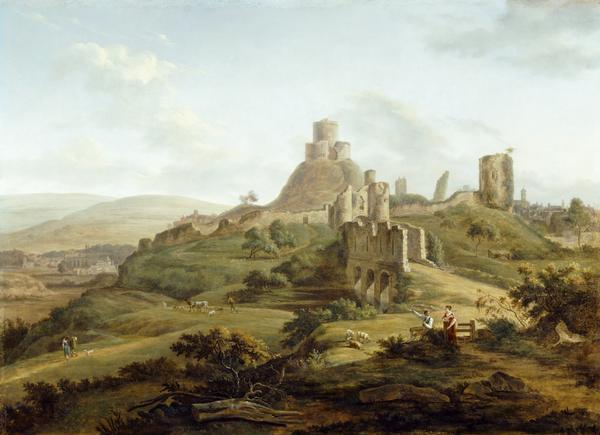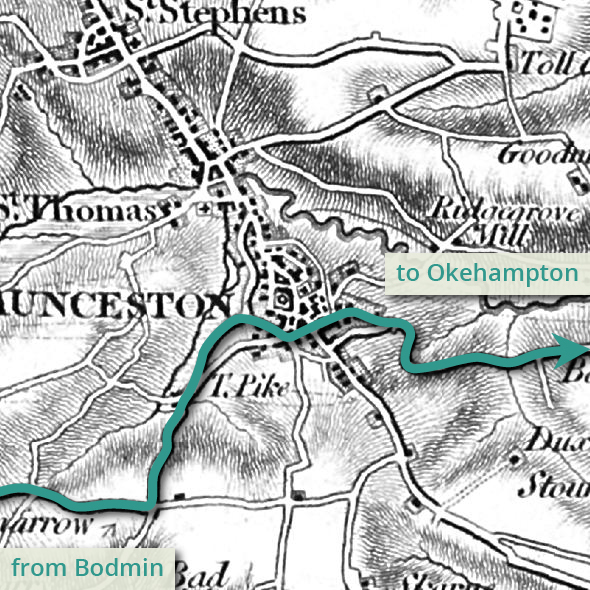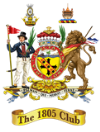Launceston
The town has its own narrow-gauge steam railway with a charming station complete with ticket office and cafe. Part of the old town wall is still in existence and incorporates the stunning Southgate arch. The handsome White Hart Hotel incorporates a Norman doorway possibly removed from the Friary at St Thomas. The early 16th century granite New Bridge crosses the River Tamar and two old bridges cross the River Kensey: one mediaeval and one built in 1580.
Like many Cornish towns there are many chapels in Launceston and a number of fine Georgian houses. Lawrence House, a Grade II listed building on Castle Street, houses the town museum and Madford is a beautiful old house built just after the English Civil War.
Return to overview

Launceston Castle by Hendrik-Frans De Cort (1742-1810)
Image in public domain (Wikimedia Commons). The view was taken from St Catherine's Hill. The defended bridge and moat in the middle ground were mostly destroyed in the building of St Thomas Road in 1834. Still, this gives some idea of Launceston as Lapenotiere would have encountered it, albeit by night.
Dartmoor National Park, Lifton, Wortham, Stowford, Bridestow, Meldon.
The Trafalgar Way now enters the beautiful county of Devon, heading in a north easterly direction and brushing the northern edge of Dartmoor National Park, the largest expanse of open moorland in southern Britain. Here ponies roam its craggy landscape, defined by forests, rivers, wetlands and tors (rock formations).
Trails wind through valleys with Neolithic tombs, Bronze Age stone circles and abandoned medieval farmhouses. The area is dotted with beautiful rural villages. Remember, for the Postcards competition you can include images of scenes up to a few miles away (see guidelines). We know that Dartmoor has many beauties to capture and share, but our priority is for scenes that illustrate The Trafalgar Way itself.
At Lifton Lieutenant Lapenotiere would have encountered the Arundel Arms which was at that time a coaching inn called The White Horse. A plaque commemorates its place in the Trafalgar Way story. The large Gothic mansion of Lifton Park was built in 1805, the year of Trafalgar, but suffered major damage after the 2nd World War and is now mainly a picturesque ruin.
Another fine manor is the much older Wortham, built in the early 16th century and now owned by the Landmark Trust.
Stowford is attractive and its Church of St John the Baptist has an ancient stone standing at the entrance with the mysterious inscription “Gunglei”. Nearby is the historic Hayne Manor - now a commercial pheasant shoot.
The gorgeous village of Bridestowe (pronounced Brid-duh-stow) is 6 miles south-west of Okehampton on the edge of Dartmoor and on the A30 main road. There is a plaque on a stone on the village green commemorating the fact that Lieutenant Lapenotiere passed this way with his message. The village has a Methodist chapel and a parish church which is mostly 13th and 15th century. Nearby is the Elizabethan mansion Great Bidlake, the seat of the Bidlake family since 1268 (now a large holiday rental). The area is dotted with mine-workings which once produced lead and copper.
The hamlet of Meldon has a nearby quarry where the Dartmoor Railway terminates. Trains used to cross the dramatic Meldron Viaduct (now a Scheduled Monument) which is part of the Granite Way, a long distance cycle track which crosses Dartmoor. Meldon also boasts the Meldon Reservoir which extends 1.2 km from the West Okement Valley.







